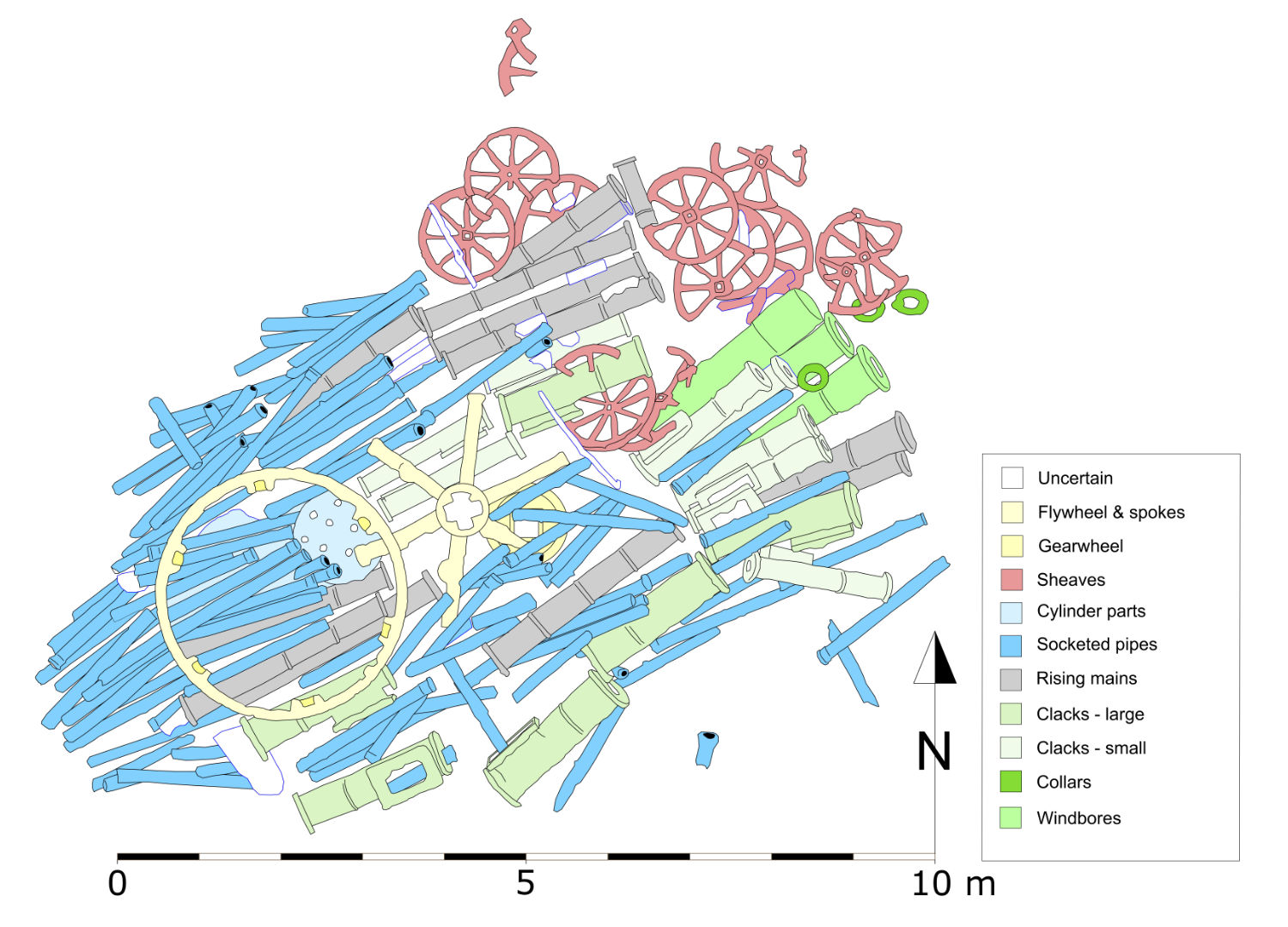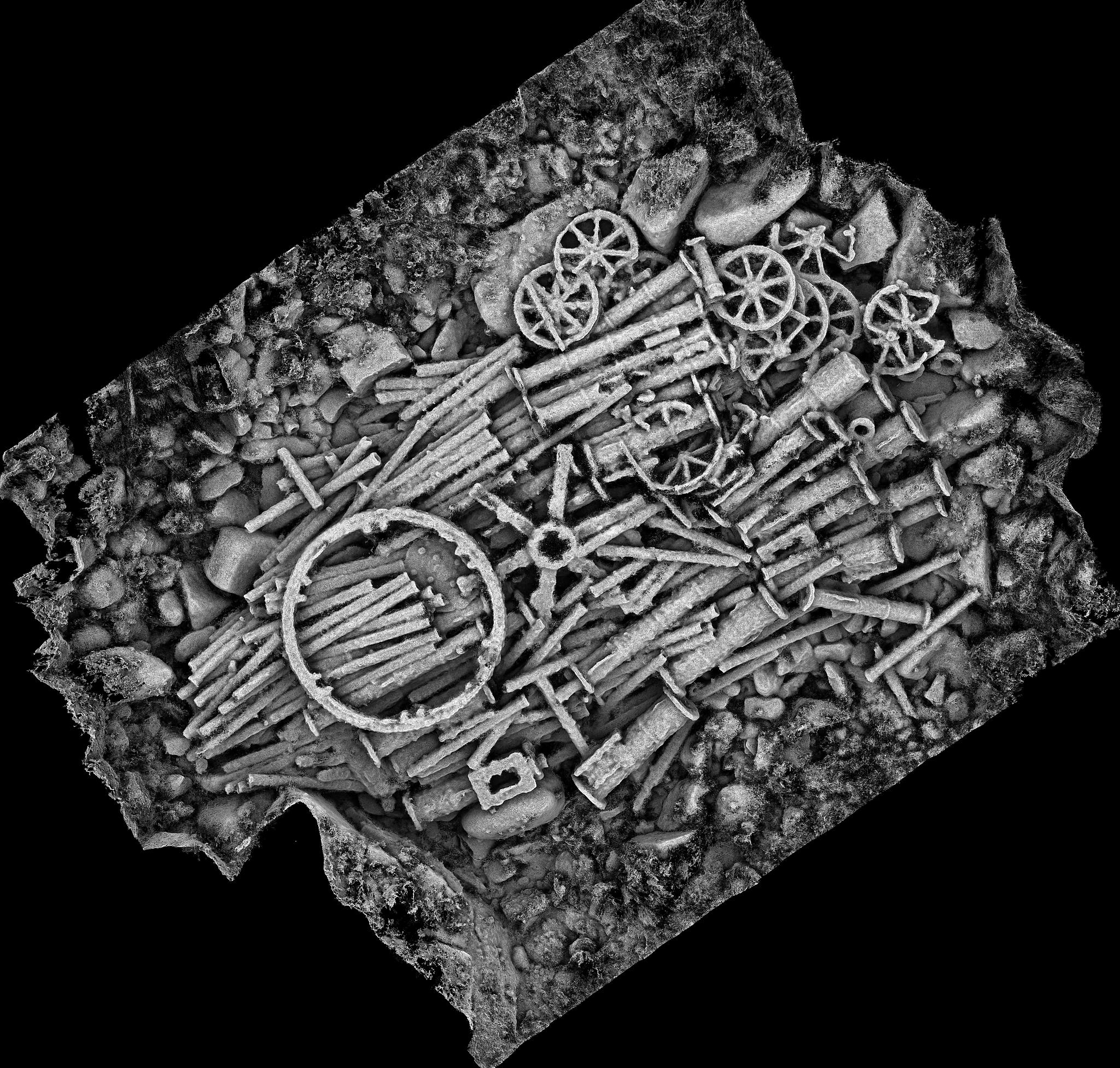Wheel Wreck: Intro | Cargo mound | Iron cylinder |Remains of the vessel | 3D site plan | Dive video
Cargo Mound: Intro and components list | Explore the cargo | 3D model
This section introduces the cargo mound and lists the components found in the 2018 CISMAS site survey (see table below).

Introduction
The cargo mound is some 12m long and 7m wide, and while the depth of the mound varies it is never more than 1m – and considerably less in places. The cargo forms an essentially rectangular mound and the individual elements appear to be stacked in an orderly fashion with the various pipes aligned along the long axis of the rectangle.
The overall impression is that the cargo was confined within the hold of the vessel transporting it and that it has not shifted significantly since it was loaded. Many of the individual elements are stacked next to similar items, for example the windbores, sheaves and socketed pipes.

The cargo seems to have been loaded with the most delicate objects on the top (the flywheel rim and the sheaves). In many cases larger pipes and clack valves have had socketed pipes placed within them, presumably to save space. All the cargo items appear to be made of cast iron and as such would be brittle and subject to breakage. The majority of the cargo is still intact; the most numerous breakages have occurred in the sheave wheels – only three wholly intact, and the socketed pipes – where several have been broken.
Explore the functions of the components, along with photographs and reconstruction drawings, and view a detailed annotated 3D model.
Cargo items
The following is a synopsis of the items which make up the cargo mound. A PDF with further details is available, and may be easier to read on a mobile device. To put the cargo in context, a table of mining milestones has been compiled.
| Item | No | Comment |
| Socketed Pipe | 100 | Cast iron pipe with a socket at one end – the plain end fits inside the socketed end. Fitted together, each pipe probably covers 6ft ? thus at least 600ft of pipe. Analysis has determined that these pipes are made of white cast iron |
| Large Clack | 6 | Clack pieces. No clack doors were found. These could also be bucket/lift pump inspection hatches (which look identical) See(Pole, 1844) |
| Small Clack | 8 | Smaller clack pieces are the same length but have smaller diameter pipe and flanges ? door openings are also slightly smaller; no clack door covers were seen. These could also be bucket pump inspection hatches (which look identical) |
| Sheaves | 12 | Eight spoked iron sheave wheels. Only three are completely intact. Central hole is square (0.06*) The eight spokes radiate from this square hub. The outer rim has runnel, probably for rope |
| Rising Main Small | 11 | Cast iron flanged pipes. Each has three evenly spaced reinforcing bands on the outside of the pipe. Probably eight-inch rising mains. |
| Rising Main Large | 2 | At least two of the rising mains are of a larger diameter (RM2 & RM5) with the same length, but greater diameter of pipe and flange. Possibly10-inch rising mains |
| Large Wheel Rim | 1 | Cast iron 10ft diameter wheel rim ? possibly part of a rotative (whim) engine. Gear teeth cast into the outer rim (probably 126T). Six sockets are cast into the inner face of the rim ? probably for the attachment of the spokes. |
| Wheel Spokes | 1 | Hub with six spokes which appear to fit into sockets in the wheel rim (LW1). The central hole in the hub is cross-shaped |
| Cylinder | 1 | One section of cast iron cylinder (broken at one end) and several fragments ? one fragment has a rectangular opening. The flanges on the end of C6 and C1 have regular bolt holes. Possibly the remains of a steam engine cylinder |
| Windbore | 3 | Cast iron pipes with one end closed and the other end open with flanges. Windbores are the sieve on the end of the pipe column. There are three windbores stacked next to each other. Note the large flange diameter and longer than usual length |
| Small Wheel | 1 | Cast iron wheel with at least 11 square-headed bolts, possibly holding multiple disks together. The diameter suggests this is possibly part of the iron cylinder (C6) ? piston?? |
| Small Wheel | 1 | Cast iron disk with a central hole. The diameter is an estimate ? not possible to measure ? item is badly obscured by overlying elements. Cylinder head? |
| Small Wheel | 1 | Cast iron wheel ? sits under the wheel spokes (LW2) and socketed pipes. Central 0.30m square ?drive? hole. Teeth match those on the flywheel in size and pitch (42T) |
| Collars | 3 | Short iron tubes with possible shallow iron flange. Possibly associated with the windbores (W1-3) ? use uncertain |
| Rod | 2 | Round sectioned iron bar, one 1.15m long other 1.5m long- function unknown |
| Box | 1 | Iron box, no top and front partly missing. Appears to be cast iron 0.012m thick. Located under W1 and partly hidden. |
| Bar | 1 | Located under (CL2) – possibly solid bar with rectangular ?socket? at eastern end – possibly a coupling? |
| CARGO TOTAL | 155 |
The table above lists the 155 separate cargo items identified to date. There are more items in the cargo mound which are buried beneath the visible items – it is difficult to estimate how many. The estimated weights give some idea of the magnitude of the cargo – certainly at least 30 tonnes in total and possibly as much as 50 tonnes when making allowance for ‘hidden’ items.
Archaeological report
The full Wheel Wreck report is available from CISMAS (PDF, 12.4MB).